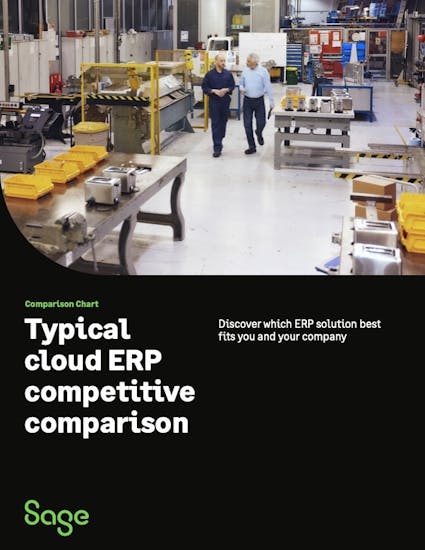Sage ERP Software Systems Comparison
Compare ERP systems from Sage, one of the world’s largest ERP vendors, founded in 1981 and headquartered in Newcastle upon Tyne, England. Sage is particularly known for serving small and medium-sized businesses, with 6+ million customers using its software worldwide.
Sage’s ERP and business management product line includes Sage Intacct, Sage 100/300cloud, and Sage X3, which cover accounting, financials, supply chain, payroll, and more for companies across industries such as professional services, construction, manufacturing, and retail. As the third-largest supplier of enterprise resource planning software globally, Sage emphasizes ease of use and accessibility – its cloud-enabled platforms are designed to simplify business processes and provide real-time insights, allowing smaller companies to manage finances, operations, and people with enterprise-grade capabilities without extensive IT resources. Read our selection guide.
4 ERP Systems Found
Price RangeN/A |
Price Range$5K - $50K |
Price Range$15K - $30K |
Price Range$25K - $250K |
Cost Per User$50/mo |
Cost Per User$69/mo |
Cost Per UserN/A |
Cost Per User$75/mo |
Deployments
Cloud
On-Premise
|
Deployments
Cloud
On-Premise
|
Deployments
Cloud
On-Premise
|
Deployments
Cloud
On-Premise
|
Retention Rate
83%
|
Retention Rate
92%
|
Retention Rate
95%
|
Retention Rate
N/A
|
Version2020.0 |
VersionContinuous Deployment |
VersionAlways Current |
VersionV12 |
Financing OptionsSubscription |
Financing OptionsLease, Subscription |
Financing OptionsSubscription |
Financing OptionsFinance, Subscription |
User Range1 — 100 |
User Range1 — 1000 |
User Range10 — Unlimited |
User Range10 — 1000 |
Minimum Fee to Implement$5,000 |
Minimum Fee to Implement$10,000 |
Minimum Fee to ImplementN/A |
Minimum Fee to Implement$100,000 |
Awards4 |
Awards- |
Awards3 |
Awards- |
Installs30,000+ |
Installs40,000+ |
Installs5,000+ |
Installs7000 |
ArchitectureSOA, SaaS |
ArchitectureSOA, SaaS |
ArchitectureSOA, .NET, Hosted Cloud, SaaS, Single-tenant, Multi-tenant, Native Cloud |
Architecture.NET |
System SummarySage 100cloud is a business management solution aimed at small and mid-sized companies. It promises to boost productivity and collaboration with cloud access and increase revenue year over year. Users benefit from comprehensive controls, bank-level security, and compliance maintenance. |
System SummarySage 300 Cloud facilitates increased collaboration and control over business operations with its cloud-based management solution, offering significant scale-up capability in the Azure environment. It's targeted at the North American market, with the typical user range between 5 to 10 users, and provides cost-effective, up-to-date solutions for growing businesses. |
System SummarySage Intacct is a premier cloud financial management and accounting software, specifically beneficial for small manufacturers aiming to streamline their financial operations. Endorsed by the AICPA as its chosen provider for such services, Sage Intacct provides small manufacturers with real-time financial insights, enabling them to optimize inventory, manage costs, and make data-driven decisions. |
System SummarySage X3 ERP is a flexible, web-based software suite for financial, sales, and operational management, suitable for global, multi-currency businesses. It provides customizable workflows, mobile responsiveness, and integration with third-party systems, focused on efficiency and scalability. |
Core Features
|
Core Features
|
Core Features
|
Core Features
|
Unique Features
|
Unique Features
|
Unique Features
|
Unique Features
|
Limitations
|
Limitations
|
Limitations
|
Limitations
|
|
ERP System Details
|
ERP System Details
|
ERP System Details
|
ERP System Details
|
Sage ERP: A Complete Vendor Profile
In this ERP selection guide we cover

With over 10,000 companies using Sage ERP solutions worldwide, Sage has established itself as a standout choice for manufacturers and distributors seeking an integrated business management system.
Sage offers four main ERP platforms: Sage X3, Sage 100, Sage 300, and Sage Intacct. Each system targets different business sizes and operational needs, from small discrete manufacturers to global enterprises managing complex supply chains.
What makes Sage particularly relevant for manufacturing is their recent focus on AI-powered features. The company launched an AI Copilot for Sage X3 in 2025, designed specifically for manufacturing and distribution businesses. This allows users to ask natural language questions about order fulfillment, inventory levels, and production status instead of navigating through multiple reports.
Manufacturing companies represent one of the top three industries using Sage ERP systems. The company has tailored its solutions to handle discrete manufacturing, process manufacturing, and custom manufacturing environments, supporting everything from make-to-stock operations to complex build-to-order scenarios.
This profile examines each Sage ERP system from a manufacturing perspective, covering key features, ideal business sizes, and implementation factors.
About Sage
Sage was founded in 1981 in the United Kingdom as a small business accounting software company. The company went public in 1989 and expanded internationally throughout the 1990s. Sage currently operates in 23 countries and serves over 6.1 million customers worldwide.
Sage’s Place in the ERP Market
Sage holds approximately 3.6% of the overall ERP market, competing against larger players including Microsoft Dynamics (28.35% market share), Workday (11.88%), and SAP (10.08%). The company’s customer base is geographically concentrated, with 48.56% of customers in the United States, 13.86% in France, and 11.12% in the United Kingdom.
Sage’s Approach to Enterprise Resource Planning
Sage employs a modular approach to ERP, offering different solutions tailored to specific business sizes and industries. The company emphasizes cloud connectivity across its ERP platforms while maintaining flexibility for on-premise deployments.
Sage’s manufacturing focus centers on three key areas:
Production Integration: Systems connect production planning, inventory management, and financial reporting in real-time.
Supply Chain Visibility: ERP systems include tools for tracking materials from procurement through production to delivery.
Scalable Architecture: Each Sage ERP platform allows businesses to add modules and functionality as operations expand.
Key Strengths and Differentiators
Industry-Specific Manufacturing Features: Sage provides solutions for process manufacturing, custom manufacturing, and discrete manufacturing. The systems accommodate complex manufacturing scenarios, including make-to-order, configure-to-order, assemble-to-order, make-to-stock, and mixed-mode environments.
AI-Powered Intelligence: The introduction of Sage Copilot for X3 enables users to ask natural language questions about customer order fulfillment, inventory status, and production metrics.
Mid-Market Focus: Sage’s customer base predominantly consists of companies with 100 – 249 employees, followed by smaller businesses with 20 – 49 employees.
Flexible Deployment Options: Sage offers cloud, on-premise, and hybrid deployment models across its ERP portfolio. Compare the top recommended cloud-based systems here.
Overview of Sage’s ERP Systems
Sage operates a multi-product ERP strategy, offering four distinct platforms designed for different business sizes and operational complexities. All systems emphasize cloud connectivity while maintaining on-premise deployment options.
Sage X3
Target Market: Mid-sized manufacturing and distribution companies (50−1,000 employees)
Deployment: Cloud, on-premise, or hybrid
Sage X3 serves as the company’s flagship manufacturing ERP solution, designed for discrete and process manufacturing environments. The system handles complex scenarios, including make-to-order, configure-to-order, assemble-to-order, and mixed-mode manufacturing.
Key manufacturing features include production planning and scheduling, shop floor control, quality management, and integrated supply chain management. The AI Copilot allows users to query production status, inventory levels, and customer order fulfillment through natural language.
Sage 100
Target Market: Small to mid-sized manufacturers and distributors (10−250 employees)
Deployment: Cloud-connected with on-premise components
Sage 100 focuses on discrete manufacturing processes, including make-to-stock and build-to-order operations. The system integrates job management tools with financial management, providing real-time cost tracking and production visibility.
Manufacturing capabilities include bill of materials management, production scheduling, inventory control, and shop floor data collection through barcode integration.
Sage 300 Cloud
Target Market: Mid-sized businesses with global operations (100−500 employees)
Deployment: Cloud and on-premise options
Sage 300 Cloud emphasizes multi-currency, multi-location financial management for manufacturers with international operations. Features include advanced inventory management across multiple locations, comprehensive financial reporting with multi-currency support, and integrated purchasing and sales order management.
Sage Intacct
Target Market: Growing businesses requiring advanced financial management (50 – 1,000+ employees)
Deployment: Cloud-native
Sage Intacct is primarily a financial management system, but can be extended for manufacturing operations through the Sage Distribution and Manufacturing Operations (SDMO) add-on. The system excels in financial reporting, budgeting, and analytics, with manufacturing extensions covering inventory management, production tracking, and cost accounting.
Compare all four ERP systems side-by-side on this Sage Software System Comparison Page.
Implementation and Support with Sage
Sage follows a structured six-phase implementation methodology:
- Discovery and Planning
- Design
- Development
- Testing
- Deployment
- Post-Go-Live Support
Change management is critical during implementation, requiring effective communication, training, and phased rollouts.
Support, Upgrades, and Maintenance Services
Sage Business Care offers different service plans allowing businesses to select appropriate support levels. Technical support includes phone and email support during business hours, with 24⁄7 support available for mission-critical applications.
Sage provides new Sage X3 release updates twice per year, with regular maintenance patches between major releases. Annual software reviews are recommended to ensure ERP systems continue operating efficiently.
Sage ERP System Resources
The following resources provide detailed insights into real-world Sage ERP implementations and technical guidance for manufacturing businesses considering or optimizing their ERP systems.
Sage ERP Case Studies
These case studies showcase specific implementations across different manufacturing sectors, highlighting problems faced, solutions implemented, and measurable results achieved using Sage ERP products.
Sage ERP White Papers
These white papers address key manufacturing topics, including production planning methodologies, inventory management strategies, supply chain optimization, and financial management practices.
Sage ERP Demos
Sage offers interactive demonstrations conducted by specialists or certified partners who can tailor demonstrations to specific manufacturing scenarios. Participating in a demo is essential for evaluating how Sage ERP systems will handle manufacturing workflows specific to your business.
Request demos and free trials of Sage products here.
FAQs
Manufacturing executives frequently ask similar questions when evaluating Oracle’s ERP portfolio. These answers address common concerns about platforms, implementation approaches, and long-term value.
Which Sage ERP system is best for manufacturing businesses?
The choice depends on business size and complexity. Sage X3 suits mid-sized manufacturers with complex operations, Sage 100 serves smaller discrete manufacturers, Sage 300 works for global operations requiring multi-currency support, and Sage Intacct offers advanced financial management.
Can Sage ERP systems handle both discrete and process manufacturing?
Yes, Sage X3 supports discrete manufacturing and process manufacturing, including make-to-order, configure-to-order, and mixed-mode operations. Sage 100 focuses on discrete manufacturing processes.
How long does Sage ERP implementation typically take?
Small to mid-sized manufacturers typically require 3 – 6 months for Sage 100 implementations, while Sage X3 implementations range from 6 – 12 months for complex operations.
What ongoing costs should manufacturers expect?
Ongoing costs include annual maintenance fees, support services, and potential upgrade expenses. Sage Business Care plans offer different service levels.
Can Sage ERP systems integrate with existing equipment?
Sage ERP systems offer integration through APIs, connectors, and adapters to connect with manufacturing equipment and business applications.












